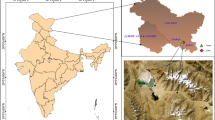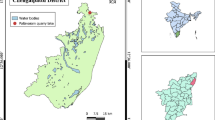Abstract
PAHs (polycyclic aromatic hydrocarbons) increases the potential harm to ecosystem and human health. The fungi is considered as a powerful choice for degradation of PAHs. The researches on the effect of PAHs on fungal population in sediment/soil mostly stayed in the laboratory simulation that is based on extreme pollution. This study investigated the fungal population of the urban wetland by high-throughput sequencing in-situ micro-pollution state. Our statistical analysis revealed significant difference in the whole fungal population at the phylum among three land use types in typical urban wetland. Among them, Ascomycota was the dominant fungi at the phyla in three land use types. Fungal genus of degrading PAHs were significantly correlated with Dibenz[a, h]anthracene (P = 0.018) in ditch wetland, Total Organic Carbon (P = 0.02) and Fluoranthene (P = 0.04) in riverine wetland, and Electrical Conductivity (P = 0.018) in agricultural land. PICRUSt (Phylogenetic Investigation of Communities by Reconstruction of Unobserved States) suggested that 20 enzymes were present related to PAHs metabolism in three land use types. Specifically, monoxygenase, dehydrogenase, and laccase were most abundant among inferred enzymes, indicating that the urban wetland had potential for the degradation of PAHs. This study contributed to in-depth understanding of the structure and function of fungal population and provided a theoretical basis for PAHs microbial remediation in the in-situ environment.






Similar content being viewed by others
Data availability
Raw amplicon sequence data related to this study were deposited in the NCBI Sequence Read Archive (NCBI SRA) under Bioprojects PRJNA817351.
References
Banan S, Khaled EH, Mohamad EH, Helene B, Farouk J (2018) Impact of Lebanese practices in industry, agriculture and urbanization on soil toxicity. Evaluation of the polycyclic aromatic hydrocarbons (PAHs) levels in soil. Chemosphere 210:85–92. https://doi.org/10.1016/j.chemosphere.2018.06.178
Baumard P, Budzinski H, Garricues P (1998) Polycyclic aromatic hydrocarbons in sediments and mussels of the western Mediterranean Sea. Environ Toxicol Chem 17(5):765–776
Berga M, Szekely AJ, Langenheder S (2012) Effects of disturbance intensity and frequency on bacterial community composition and function. PLoS ONE 7(5):e36959. https://doi.org/10.1371/journal.pone.0036959
Cerniglia CE, Sutherland JB (2010) Degradation of polycyclic aromatic hydrocarbons by fungi. In: Rother M (ed) Handkook of hydrocarbon and lipid microbiology. Springer Berlin Heidelberg, Berlin Heidelberg, pp 2080–2101
Cordova-Kreylos AL, Ca Y, Green PG, Hwang H, Kuivila KM, Michael G et al (2006) Diversity, composition, and geographical distribution of microbial communities in California salt marsh sediments. Appl Environ Microb 72(5):3357–3366. https://doi.org/10.1128/AEM.72.5.3357-3366.2006
De Lorenzo V (2008) Systems biology approaches to bioremediation. Curr Opin Biotech 19(6):579–589. https://doi.org/10.1016/j.copbio.2008.10.004
Ellen K, Aurelia G, Runa SB, Karolin M, Thilo R, Margarida S et al (2019) The mineralosphere—succession and physiology of bacteria and fungi colonizing pristine minerals in grassland soil under different land-use intensities. Soil Biol Biochem 136:107534. https://doi.org/10.1016/j.soilbio.2019.107534
Fan B, Wang XN, Huang Y, Li Q, Gao XY, Li WW, Liu ZT (2019) Distribution and risk assessment of polycyclic aromatic hydrocarbons in water. Environ Sci 40(5):2011–2014
Ghizelini AM, Martins KG, Gieselmann UC, Santoro E, Pasqualette L, Mendonca-Hagler LCS et al (2019) Fungal communities in oil contaminated mangrove sediment—who is in the mud? Mar Pollut Bull 139:181–188. https://doi.org/10.1016/j.marpolbul.2018.12.040
Hadibarata T, Khudhair AB, Salim MR (2012) Breakdown products in the metabolic pathway of anthracene degradation by a ligninolytic fungus Polyporus sp.S133. Water Air Soil Poll 223(5):2201–2208. https://doi.org/10.1007/s11270-011-1016-1
Haritash AK, Kaushik CP (2009) Biodegradation aspects of polycyclic aromatic hydrocarbons(PAHs): a review. J Hazard Mater 169(1–3):1–15. https://doi.org/10.1016/j.jhazmat.2009.03.137
Huang YP, Sun X, Liu M, Zhu JM, Yang J et al (2019) A multimedia fugacity model to estimate the fate and transport of polycyclic aromatic hydrocarbons ( PAHs) in a largely urbanized area, Shanghai, China. Chemosphere 217:298–307. https://doi.org/10.1016/j.chemosphere.2018.10.172
Jiang Y, Zhang Z, Zhang XM (2018) Co-biodegradation of pyrene and other PAHs by the bacterium Acinetobacter johnsonii. Ecotox Environ Safe 163:465–470. https://doi.org/10.1080/10934529.2017.1409579
Jones EBG (2000) Marine fungi: some factors influencing biodiversity. Fungal Divers 4:53–73
Juhasz AL, Naidu R (2000) Bioremediation of high molecular weight polycyclic aromatic hydrocarbons: a review of the microbial degradation of benzo[a]pyrene. Int Biodeter Biodegr 45(12):57–88. https://doi.org/10.1016/S0964-8305(00)00052-4
Langille MGI, Zaneveld J, Caporaso JG, McDonald D, Knights D, Reyes JA et al (2013) Predictive functional profiling of microbial communities using 16S rRNA marker gene sequences. Nat Biotechnol 31(9):814–821. https://doi.org/10.1038/nbt.2676
Li CH, Zheng XK, Niu SF, Cai YP, Shen N, Pang AP (2009) Research progress in protection and restoration of urban wetland. Prog Phys Geog 28(2):271–279. https://doi.org/10.1109/CLEOE-EQEC.2009.5194697
Li XF, Hou LJ, Liu M, Zheng YL, Li Y, Lin XB (2015) Abundance and diversity of polycyclic aromatic hydrocarbon degradation bacteria in urban roadside soil in Shanghai. Appl Microbiol Biot 99:3639–3649. https://doi.org/10.1007/s00253-014-6299-x
Li ZJ, Guo CC, Shi J, Lin KF, Cao GM, Cui XZ (2017) Diversity of bacterial community in Suaeda roots rhizosphere growth in PAHs-contaminated saline soil estimated by high throughput sequencing method. Microbiol China 44(7):1602–1612. https://doi.org/10.13344/j.microbiol.china.170164
Li Y, Liu M, Li RK, Sun P, Xia H, He TH (2020) Polycyclic aromatic hydrocarbons in the soils of the Yangtze River Delta Urban Agglomeration, China: influence of land cover types and urbanization. Sci Total Environ 715:137011. https://doi.org/10.1016/j.scitotenv.2020.137011
Liang X, Guo C, Liao C, Liu S, Wick LY, Peng D et al (2017) Drivers and applications of integrated clean-up technologies for surfactant-enhanced remediation of environments contaminated with polycyclic aromatic hydrocarbons (PAHs). Environ Pollut 225:129–140. https://doi.org/10.1016/j.envpol.2017.03.045
Liu J, Chen X, Shu HY, Lin XR, Zhou QY, Bramryd T et al (2018) Microbial community structure and function in sediment from e-waste contaminated rivers at Guiyu area of China. Environ Pollut 235:171–179. https://doi.org/10.1016/j.envpol.2017.12.008
Ma WL, Liu LY, Tian CG, Qi H, Jia HL, Song WW et al (2015) Polycyclic aromatic hydrocarbons in Chinese surface soil: occurrence and distribution. Environ Sci Pollut Res 22:4190–4200. https://doi.org/10.1007/s11356-014-3648-3
Maliszewska-Kordybach B (1996) Polycyclic aromatic hydrocarbons in agricultural soil in Poland: preliminary proposals for criteria to evaluate the level of soil contamination. Appl Geochem 11:121–127. https://doi.org/10.1016/0883-2927(95)00076-3
Ministry of environmental protection, Ministry of land and resources (2014) National soil pollution survey Bulletin. China Environmental Protection Industry, pp 5–10
Mukherjee S, Juottonen H, Siivonen P, Quesada CL, Tuomi P, Pulkkinen P et al (2014) Spatial patterns of microbial diversity and activity in an aged creosote-contaminated site. ISME J 8(10):2131–2142. https://doi.org/10.1038/ismej.2014.151
Nasrin YA, Behnam K, Farid M, Michael K, Mohammad Y, Ahmad RL (2018) Presence of polycyclic aromatic hydrocarbons in sediment and surface water from Shadegan wetland-Iran: a focus on source apportionment, human and ecological risk assessment and Sediment-Water Exchange. Ecotoxicol Environ Safe 148:1054–1066
Page DS, Boehm PD, Douglas GS, Bence AE, Mankiewicz PJ (1999) Pyrogenic polycyclic aromatic hydrocarbons in sediment record past human activity: a case study in Prince William Sound, Alaska. Mar Pollut Bull 38:247–260. https://doi.org/10.1016/S0025-326X(98)00142-8
Potin O, Rafin C, Veignie E (2004) Bioremediation of an aged polycyclic aromatic drocarbons(PAHs)-contaminated soil by filamentous fungi isolated from the soil. Int Biodeterior Biodegrad 54(1):45–52. https://doi.org/10.1016/j.ibiod.2004.01.003
Ren C, Wu Y, Zhang S, Wu LL, Liang XG, Chen TH et al (2015) PAHs in sediment cores at main river estuaries of Chaohu Lake: implication for the change of local anthropogenic activities. Environ Sci Pollut Res 22:1687–1696. https://doi.org/10.1007/s11356-014-3141-z
Samanta SK, Singh OV, Jain RK (2002) Polycyclic aromatic hydrocarbons: environmental pollution and bioremediation. Trends Biotechnol 20(6):243–248. https://doi.org/10.1016/S0167-7799(02)01943-1
Shen C, Xiong J, Zhang H, Feng Y, Lin X, Li X (2013) Soil pH drives the spatial distribution of bacterial communities along elevation on Changbai Mountain. Soil Biol Biochem 57:204–211. https://doi.org/10.1016/j.soilbio.2012.07.013
Sheng YY, Cong J, Lu H, Yang KH, Yang LS, Wang M et al (2018) Soil fungal diversity of the timberline ecotone in Shennongjia National Park. Acta Ecol Sin 38(15):5322–5330. https://doi.org/10.5846/stxb201709211693
Smiarowski A, Macnae J, Bann G (2011) Inversion of low-induction number conductivity meter data to predict seasonal saturation variation. Geophysics 76(6):F395–F406. https://doi.org/10.1190/geo2010-0378.1
Tayssir K, Tarek R, Satinder KBR, Maximiliano C, Saurabhjyoti S, Mausam V (2017) Biodegradation of polycyclic aromatic hydrocarbons (PAHs) by fungal enzymes: a review. J Environ Sci 51:52–74. https://doi.org/10.1016/j.jes.2016.08.023
Tian J, Xu XL, Kang YS, Tang WH, Liu SQ (2018) Screening and characteristics of a broad spectrum fungus degrading polycyclic-aromatic hydrocarbons: Aspergillus flavus AD-X-1. Biotechnol Bull 34(8):115–122
Waldrop MP, Zak DR, Blackwood CB, Curtis CD, Tilman D (2006) Resource availability controls fungal diversity across a plant diversity gradient. Ecol Lett 9:1127–1135. https://doi.org/10.1111/j.1461-0248.2006.00965.x
Wang XL, Ning LM, Yu J, Xiao R, Li T (2008) Changes of urban wetland landscape pattern and impacts of urbanization on wetland in Wuhan City. Chin Geogr Sci 18(1):47–53. https://doi.org/10.1007/s11769-008-0047-z
Wang NN, Han DX, Sun X, Guo W, Ma HY, Feng FJ (2017) Effects of precipitation change on soil microbial functional diversity in the primitive Korean pine and broadleaved forests. Acta Ecological Sinica 37(3):868–876. https://doi.org/10.5846/stxb201509101873
Ward CS, Yung CM, Davis KM, Blinebry SK, Williams TC, Johnson ZI et al (2017) Annual community patterns are driven by seasonal switching between closely related marine bacteria. ISME J 11(11):26–37. https://doi.org/10.1038/ismej.2017.4
Wu L, Zhu HL (2015) Study on comprehensive treatment technique for heavily polluted urban river of the Chaohu Lake Basin-Taking the Shiwuli River as an Example. J Anhui Agric Sci 43:206–209
Wu HL, Sun BH, Li JH (2019) Polycyclic aromatic hydrocarbons in sediment/soil of the rapidly urbanized lower reaches of the River Chaohu, China. Int J Environ Res Public Health 16(13):2302. https://doi.org/10.3390/ijerph16132302c
Wu HL, Sun BH, Li JH (2021) Influence of polycyclic aromatic hydrocarbon pollution on the diversity and function of bacterial communities in urban wetland. Environ Sci Pollut Res 28:56281–56293. https://doi.org/10.1007/s11356-021-14174-0
Yang W, Lang Y, Bai J, Li Z (2014) Quantitative evaluation of carcinogenic and non-carcinogenic potential for PAHs in coastal wetland soil of China. Ecol Eng 74:117–124. https://doi.org/10.1016/j.ecoleng.2014.10.015
Yang XD, Duan LC, Chen Y, Meng FB, Li Y, He XM et al (2019) Relationship between degradation of polycyclic aromatic hydrocarbons (PAHs) and nitrogen fertilization in the desert grassland of Karamay, Xinjiang China. Acta Ecological Sinica 39(9):3153–3166
Yao L, Teng Y, Luo Y (2015) Biodegradation of polycyclic aromatic hydrocarbons (PAHs) by FS10-Cand effect of bioaugmentation on an aged PAH-contaminated soil. Bioremediat J 19(1):9–17. https://doi.org/10.1080/10889868.2014.939137
Yunker MB, Macdonald RW, Vingarzan R, Mitchell RH, Goyette D, Sylvestre S (2002) PAHs in the Fraser River basin: a critical appraisal of PAH ratios as indicators of PAH source and composition. Org Geochem 33(4):489–515. https://doi.org/10.1016/S0146-6380(02)00002-5
Zhang YX, Tao S, Cao J, Coveney RM (2007) Emission of polycyclic aromatic hydrocarbons in China by county. Environ Sci Technol 41(3):683–687. https://doi.org/10.1021/es061545h
Zhou ZF, Wang MX, Zuo XH, Hong YY (2016) Comparative Investigation of Bacterial, Fungal, and Archaeal Community Structures in soil in a Typical Oilfifield in Jianghan, China. Arch Environ Con Tox 72:65–77. https://doi.org/10.1007/s00244-016-0333-1
Funding
Research in this study was funded by the National Key Scientific Instrument and Equipment Development Grant of China (2012YQ2011308) and Natural Science Foundation of Anhui Provincial Education Department (KJ2019A0553).
Author information
Authors and Affiliations
Contributions
HW, SP and BS conceived and designed the experiments. HW performed the experiments. HW, BS and JL analyzed the data and wrote the original draft preparation. JL revised the manuscript.
Corresponding author
Ethics declarations
Conflict of interest
The authors declare no competing interests.
Additional information
Communicated by Erko Stackebrandt.
Publisher's Note
Springer Nature remains neutral with regard to jurisdictional claims in published maps and institutional affiliations.
Supplementary Information
Below is the link to the electronic supplementary material.
Rights and permissions
Springer Nature or its licensor (e.g. a society or other partner) holds exclusive rights to this article under a publishing agreement with the author(s) or other rightsholder(s); author self-archiving of the accepted manuscript version of this article is solely governed by the terms of such publishing agreement and applicable law.
About this article
Cite this article
Wu, H., Sun, B., Pan, S. et al. The diversity and function of the in-situ fungal communities in response to polycyclic aromatic hydrocarbons in the urban wetland. Arch Microbiol 205, 40 (2023). https://doi.org/10.1007/s00203-022-03378-8
Received:
Revised:
Accepted:
Published:
DOI: https://doi.org/10.1007/s00203-022-03378-8




